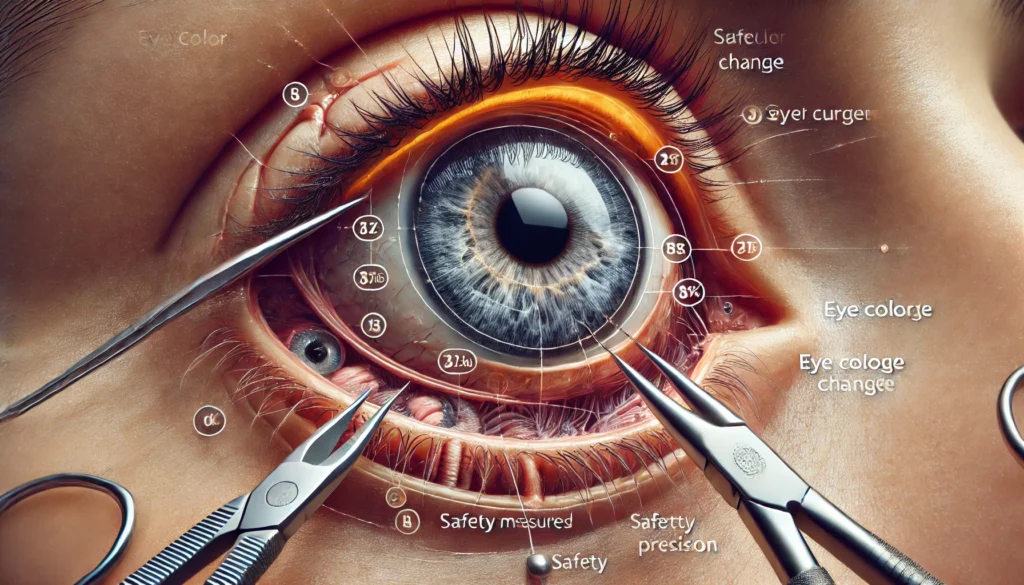Tameka “Tiny” Harris Silicone Iris Implant: Safe Cosmetic Eye Surgery or Risky Trend?

- Introduction
- Who Is Tameka “Tiny” Harris and Why Her Case Matters
- Understanding Silicone Iris Implants
- Why People Consider Cosmetic Iris Implants
- Hidden Risks—What Experts Warn
- The Medical Verdict in 2025
- Safer, Smarter Alternatives
- Conclusion: A Beauty Trend That Crossed the Line
- FAQ: Tameka “Tiny” Harris Silicone Iris Implant — Safe Cosmetic Eye Surgery or Risky Trend?
Changing your eye color is a bold and deeply personal decision—especially when it involves surgery. In this guide, we’ll explore the much-discussed case of Tameka “Tiny” Harris’s silicone iris implant, uncover real-world medical data, and help you make an informed, confident choice about cosmetic eye-color procedures.
Introduction
Back in 2014, R&B star and reality TV personality Tameka “Tiny” Harris decided to permanently change her eye color from brown to icy gray through a silicone iris implant procedure performed abroad. Her decision made headlines, inspired curiosity, and stirred controversy in the medical world.
In this article, you’ll discover:
- What the procedure involves
- The risks and long-term outcomes
- What top ophthalmologists think about it
- Safer alternatives to consider if you're thinking of changing your eye color
Let’s break it all down—professionally, clearly, and compassionately.
Who Is Tameka “Tiny” Harris and Why Her Case Matters
Tameka “Tiny” Harris gained fame as a member of the R&B group Xscape and later through her marriage to rapper T.I. In 2014, she traveled to Panamá to undergo a now-controversial cosmetic iris implant surgery. She openly promoted her experience on social media, even sharing a promo code for the procedure.
The implant used in her case, BrightOcular, was originally developed for reconstructive eye surgeries, not healthy eyes. Since then, the implant has been banned or restricted in many countries due to an alarming rate of complications.
While Tiny initially reported satisfaction and no major side effects, her case is now frequently cited by ophthalmologists as a cautionary tale of what happens when cosmetic trends outpace medical science.

Understanding Silicone Iris Implants
What Exactly Is a Silicone Iris Implant?
A silicone iris implant is a flexible, synthetic device made to either mimic or mask your natural eye color. It's inserted through a tiny incision in your cornea and unfolds over the iris, essentially covering it with a new hue.
Originally, this technology served patients with eye trauma or conditions like aniridia. But the cosmetic use—especially in otherwise healthy eyes—has raised red flags due to its invasive nature and long-term complications.
⚠️ Key Fact: The BrightOcular implant has since been linked to serious medical risks, including blindness.
How the Procedure Works—Step by Step
Let’s walk through how the surgery actually happens:
- Pre-Operative Exams – Includes checking corneal thickness, eye pressure, and iris health.
- Incision – A small (about 2.8 mm) cut is made in the cornea.
- Insertion – The implant is rolled, inserted, and unfolded to sit on top of the natural iris.
- Post-Op Recovery – Eye drops are used to prevent infection and control inflammation. Patients are typically told to avoid makeup, sunlight, and screen use for a few days to weeks.
Tiny reported some blurriness and light sensitivity after her surgery, but many patients have faced far more serious complications long after the procedure.
Why People Consider Cosmetic Iris Implants

Buzz vs. Beauty—What’s the Real Appeal?
We get it—there’s something mesmerizing about light-colored eyes. The idea of waking up with a permanent eye color you’ve always dreamed of is powerful. For many, it’s about identity, beauty, or simply trying something new.
Tiny said it herself: she wanted something different, something that felt more like her. And she got it—at least for a while.
But the truth is: the potential damage far outweighs the aesthetic reward.
Here’s a breakdown of options:
| Method | Cosmetic Use | Permanent? | Risk Level | FDA Approved? |
|---|---|---|---|---|
| Colored Contact Lenses | ✅ | ❌ | Low | ✅ |
| Keratopigmentation | ✅ | ✅ | Medium-High | ❌ |
| Iris Implants | ✅ | ✅ | Very High | ❌ |
| Laser Depigmentation | ✅ | ✅ | High | ❌ |
✅ Pro Tip: Always consult an ophthalmologist before making any decisions. Your eyes are priceless.

What Really Happens Long-Term?
While Tiny hasn’t disclosed serious complications, ophthalmologists and peer-reviewed studies present a much darker picture. Here's what the medical literature reports:
- Glaucoma: Implants block fluid drainage, raising intraocular pressure and risking permanent optic nerve damage.
- Endothelial Cell Loss: Constant friction from the implant causes corneal cell death, cloudiness, and often the need for transplant.
- Chronic Uveitis: Ongoing inflammation that leads to pain, sensitivity to light, and even scarring.
- Cataracts: The natural lens clouds prematurely, sometimes within a year post-implant.
- Infections: Rare but serious. Bacterial or fungal infections can lead to irreversible vision loss.
- Implant Removal Surgery: Most patients eventually need removal. The procedure is complex and doesn't always reverse the damage.
📚 Clinical Insight: A 2023 study found that up to 75% of patients experienced severe complications requiring additional surgeries.
The Medical Verdict in 2025

Is Cosmetic Iris Implant Surgery Safe?
The answer? A resounding no.
As of July 2025, the consensus among global ophthalmology associations is crystal clear:
- ❌ Not approved by the FDA or EMA for aesthetic use
- ❌ No long-term safety data for cosmetic candidates
- ⚠️ Deemed malpractice by many eye specialists
🗣️ “We strongly discourage anyone from undergoing iris implants for cosmetic purposes. The risks to long-term vision are too great.” – American Academy of Ophthalmology
These procedures are still performed in countries with looser regulations, but that doesn’t make them safe. If anything, it makes aftercare and accountability much harder.
Safer, Smarter Alternatives
If You Still Want to Change Your Eye Color…
Here are medically sound options:
- ✅ Colored Contacts – Custom designs, FDA-regulated, no surgery needed.
- ⚠️ Keratopigmentation – Less invasive than implants, but still experimental.
- ⛔ Laser Depigmentation – New technique; unapproved and potentially damaging.
💡 Talk to a certified eye care professional about your motivations. There may be ways to explore your desired look without compromising your health.
Conclusion: A Beauty Trend That Crossed the Line
Tameka “Tiny” Harris’s story started with empowerment and beauty—but her case now serves as a warning. Her choice, while deeply personal, has been heavily scrutinized by the global medical community.
The takeaway? When it comes to your vision, the safest option is always the one backed by science—not social media.
FAQ: Tameka “Tiny” Harris Silicone Iris Implant — Safe Cosmetic Eye Surgery or Risky Trend?
1. Who is Tameka “Tiny” Harris, and what eye surgery did she undergo?
Tameka “Tiny” Harris is a singer, songwriter, and TV personality best known for her music career and as the wife of rapper T.I. In 2014, she traveled to Panama to undergo a cosmetic eye color change surgery using a silicone iris implant. The procedure changed her brown eyes to a light “ice-gray.”
2. What are silicone iris implants, and how do they change eye color?
These are flexible, colored silicone discs surgically inserted into the eye. Once inside, the implant unfolds over the natural iris, changing the eye's apparent color. It’s marketed as a permanent cosmetic solution—but carries serious medical risks.
3. Is silicone iris implant surgery considered a safe cosmetic eye surgery in 2025?
No. As of 2025, major ophthalmology associations and regulatory bodies like the FDA and EMA strongly advise against it. The procedure is associated with a high rate of severe complications, including irreversible vision loss.
4. What are the most common dangers and complications associated with silicone iris implants?
- Glaucoma: Intraocular pressure increases, damaging the optic nerve.
- Corneal damage: Loss of endothelial cells leads to clouding and swelling.
- Uveitis: Chronic inflammation causing pain and light sensitivity.
- Cataracts: Early lens clouding requiring surgery.
- Infection: Rare but serious intraocular risks.
- Iris atrophy and implant removal: Many patients require complex explant surgeries.
5. Why did Tameka “Tiny” Harris choose this procedure, and what was her initial experience?
She expressed a long-time desire for lighter eyes and disliked wearing contact lenses. Her initial experience was positive, and she reported no side effects—though her case later became a key example of the dangers of this trend.
6. Is this surgery approved by the FDA or EMA for cosmetic use?
No. The procedure is not approved for cosmetic purposes. While some artificial iris devices (like CustomFlex) have medical approvals, their use is restricted to treating eye trauma or congenital conditions—not cosmetic enhancements.
7. Can silicone iris implants cause permanent vision loss?
Yes. Glaucoma, corneal decompensation, and chronic inflammation can lead to irreversible damage and even blindness—often requiring multiple surgeries that may not restore vision.
8. Can the procedure be reversed if problems occur?
Implants can technically be removed, but the damage they cause may be permanent. Explant surgeries carry their own risks and often don’t restore lost vision.
9. What do ophthalmologists recommend regarding this surgery?
Leading eye doctors universally discourage it. The risks far outweigh the benefits, and the procedure is considered unethical when done for non-medical reasons.
10. What is the safest alternative for changing eye color?
Colored contact lenses remain the safest and most recommended option. They're FDA-approved, non-invasive, and reversible when used properly under professional guidance.
At Eye Color Change, we’re here to help you explore safer, personalized options for achieving the look you love—without compromising your health.
Browse our trusted guides on colored contacts, keratopigmentation, or consult with our experts today.

Leave a Reply